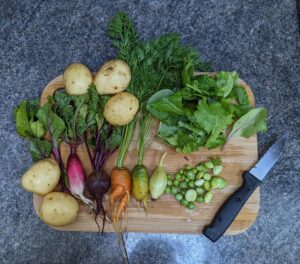And how to plan your Autumn and Winter garden
While sowing and harvests are in abundance, there are plenty of seeds you can start sowing in July.
Many forget that you can extend your garden harvests through the winter months with just a little bit of planning!
We are well into the growing season now, and I’ve just picked my first harvest of beans, peas, potatoes, beetroots and carrots!
The carrots and beetroot were particularly underwhelming and I am very much blaming my poor soil preparation – but they were still very tasty!
Through the next few paragraphs, I’ll be highlighting the main seeds I’ll be sowing for harvests from August onwards!

You’ll need to think about your ‘hardiness zone’, and the frost dates in your area.
Your hardiness zone depends on the average highest and lowest temperatures in your area – most of the UK is between zones 8 and 9 – in Warwickshire, I’m zone 8.
Different websites, unfortunately, tell you different things. I use www.plantmaps.com for everything, just to keep things uniform.
But, just to confuse things even more, the RHS have a completely different rating system for plants. I won’t go into it here, but you can download their handy PDF here.
First and last frost dates can have a huge impact on what you can grow around that time of year.
These dates have been researched to give an average date you could expect to receive a frost in your area, and can differ between locations.
Once you’ve researched your first and last frost dates, you can expect to grow all your tender plants between them without any need for frost protection.
It’s advised that you don’t follow this exactly – it’s just an average over the previous years. However, always keep an eye on the weather forecast in your area and make sure you have protection for any premature temperature drops.
You could run a Google search for ‘first/last frost date’ and your location – but I like to use this website. Which is, again, PlantMaps.
When you’ve got your window you’ll need to count back to whatever day is is right now, before you sow anything. Before you do it manually, the easiest way is to type into Google ‘how many days until…’ and your average first frost date.
According to PlantMaps, my first frost date is due between the 21st of November and the 30th.
This seems quite ambitious to me, so just to be on the safe side, I’ll take a week off that and make it the 14th! I do wonder if this is correct, though, we are in England after all and I’ll be bracing myself from around October!
At the time of writing this if the average is to be believed, I currently have 129 days in my main growing season left – so anything I plant now that is frost-tender will need to have a growing season of 129 days or less until maturity (unless you have a decent amount of protection!)
Sowing in July
This will be my first ‘over wintering’ of any sowings I make, so this will be a big experiment for me! I’ve been doing lots and lots and LOTS of research from various books and websites, and I’ve made pages of notes – so I’m hoping to get it right.
And if I don’t? Well, at least I’ve learned something!
I’ve just had a fantastic delivery from Wilko – many new seeds. If you’re looking to build a seed collection, now is the time! Lots of stores and garden centres have seeds at half price or better now that the ‘season’ is almost over.

The Seeds
Beetroot
The first thing I’ll be sowing this July (at the time of writing this, we are around two weeks in), will be beetroot.
I’ve chosen the variety ‘Boltardy’ to over winter. As the name suggests, Boltardy is resistant to bolting and will survive a light frost.
I’ve started my beetroot in plug trays in the garden, and when the seedlings start to establish I’ll transplant them into a prepared bed at the allotment.
Beetroot can be sown up until the end of August, and I’ll be sowing some more in a few weeks time to keep the harvest going.
As long as it has adequate frost protection, beetroot can be left in the ground throughout winter to harvest when needed.
Spinach
Next, there will be Spinach. I’ll be going with the varieties ‘Climbing Malabar’, ‘Renegade’, and ‘Perpetual’.
Spinach is super hardy and can withstand a light frost, and I’ll be sowing more every three weeks or so from now until the end of August to the middle of September,
I’ll cover the crops with some horticultural fleece if the temperatures look like they’re really going to drop; just to be on the safe side.
Dwarf French Beans
Radish
Next, I’ve planted some ‘Bright Lights’ radish.
Now… I don’t like radish. I tried a French Breakfast from the garden harvest a few weeks ago and I was not impressed!
However, I do have some seeds for them and it would be a shame for them to be wasted. I’ve sown a tray of the radish, and maybe I’ll keep sowing them to store and give away.
I may even try cooking some next time around – I may like them roasted!
As radishes can be harvested from around three weeks post sowing – they’re a great space filler.
Swiss Chard

I went a bit mad sowing Swiss Chard earlier in the year and it’s coming along really well at the allotment. I then sowed some more (pictured). But I’ll be sowing some more come the end of the month.
Swiss Chard, apparently, can be left in the ground over winter, and fresh leaves will appear to flourish in the Spring time. If it works, that would be fabulous!
Brussels Sprouts
These take around three months to reach maturity, sometimes longer.
I popped just 10 seeds in on the 14th of July, I’ll do maybe another 10 early August, and then again in perhaps October to (hopefully) give a continual harvest.
I recently started to keep a garden diary where I write in any seeds I’ve sown, at what date, and how many – as well as putting the date on the label. This will help me look back at this time when it comes to the garden next year.
I’ll also be able to see through the succession showing and keeping note of all the plants what the best time to sow was and under what conditions they thrive.
I went for the Brodie variety PURELY because the picture had a stalk of Brussels covered in frost. I’m hoping that it might be some indication of hardiness?!

Purple Sprouting Broccoli

This previous weekend, I also sowed some purple sprouting broccoli. Going by most of the advice I’ve read, I’m a little bit late to the party on this one.
BUT, these things are meant to try us, and I’ll be giving it a go anyway! I’ve multisown the seeds in some seed cell trays and will transplant out when they’re big enough to survive in the big, wide world – which is between 5 and 6 inches tall.
**As a side note (more for myself!), today is the 14th. These seeds took only 3 days to start to sprout!
Swede
I’ve read that swedes should be sowed up until June… Well. We’re in July now and I’ve just put some in.
Swede isn’t a vegetable I would ever buy from the store to cook and eat, but Wilko had the seeds cheap – and according to my seed packet, July is fine! So, again, I’m giving them a go.
I’ve sown them in cell trays to transplant them out later, and hopefully harvest through the winter.
Swede is another one that I’ve never grown before, so we’ll see!

Peas
The variety ‘Kelvedon Wonder’ (of which I have so many seeds of I can hardly believe it) are suitable, apparently, to sow into Autumn and will overwinter if given protection for an early harvest.
As you might have guessed by now, the theme of this blog post is ‘give it a go’ – so that’s what I’ll be doing.
I’ve sown the peas in modules (on the 11th) since every time I sow peas direct into the ground, something eats them.
I’m guessing it’s the birds that swoop down as soon as the cotyledons emerge from the soil, but it could just as easily be mice – either way I am NOT here for it!
Kale
And finally, kale. Kale is a fantastic brassica that will survive some frost, so you can bet I’ve planted it in abundance! I absolutely love snacking on kale through the day.
I’ve got a few varieties of Kale going already, ‘Black Magic’, ‘Sympatic’, and ‘Dwarf Green Curled’. As I’ve not got seeds for any others, I’ll be alternating succession sowings of each every three or so weeks.

Experiments!

Being a naturally curious (read: nosy) person, I’ve decided to try something else new.
I purchased from Tesco a bag of dried pinto beans, dried cannellini beans, and lentilles vertes (whole green lentils).
And I planted some. I didn’t research the conditions, or the time it takes to grow them, or any of that business. I just wanted to see if they would germinate… and they did!
I’ve since done a quick Google search on the lentils, which says to plant in Spring and harvest at the beginning of Summer, so I probably won’t get anything from them. But, it’ll be really interesting to see how they grow!
Cannellini take around 75 days to mature, and Pinto anywhere between 90-150, apparently. So I may get a harvest from the cannellini… we’ll see about the pinto!
Either way it’s a fun experiment, and so far they’ve all germinated.
Full List of July Sowings
Variety: Boltardy
Sown on: Monday the 11th July
Harvest: October onwards.
Will I sow again?
Yes, at the end of the month and again in the middle of August.
Variety: Brodie F1
Sown on: Thursday 14th July
Harvest: October onwards.
Will I sow again?
Yes, in the first week of August and the first week of October to leave in over winter.
Variety: Purple Sprouting Broccoli
Sown on: Monday the 11th July
Harvest: January onwards.
Will I sow again?
Probably not. Depending on how these seedlings do, I may sow a small amount in the middle of August for an insurance policy!
Variety: Autumn King
Sown on: Monday 11th July
Harvest: November/December onwards
Will I sow again?
Yes. Autumn King cabbage is suitable to over winter, so I’ll do a further sowing in the middle of August.
I may decide to try a different variety in August as an experiment, we’ll see how I feel at the time!
Variety: White Silver 2
Sowing at: the end of July
Harvest: Through Winter, into Spring
Variety: Polka
Sown on: Tuesday the 12th of June
Harvest: Hopefully from September until the plant dies off with the cooler weather.
Will I sow again?
Not until the Spring.
Variety: Canadian Wonder
Sown on: Tuesday the 12th of June
Harvest: Same as the Polka variety; hopefully from September until the plant dies off.
Will I sow again?
Not until the Spring.
Variety: Green Curly Kale
Sown on: Monday 11th June
Harvest: Middle of August onwards – as soon as the leaves are big enough to pick.
Will I sow again?
Yes, different varieties every three weeks or so for a continuous harvest.
Variety: Shanghai
Sown on: Saturday 16th July
Harvest: End of August onwards, throughout Winter
Will I sow again?
Yes, different varieties every three weeks or so for a continuous harvest.
Variety: Kelvedon Wonder
Sown on: Monday 11th June
Harvest: As soon as it starts to produce to when it finishes.
Will I sow again?
Yes, every three weeks under protection from any frosts – just to see what happens!
Variety: Bright Lights
Sown on: Tuesday 12th June
Harvest: Middle of August onwards until they’re all gone.
Will I sow again?
If I end up liking them, yes. Not if I don’t!
Variety: Renegade
Sown on: Monday 11th June
Harvest: Middle of August onwards – as soon as the leaves are big enough to pick.
Will I sow again?
Yes, alternating varieties ‘Reneade’, ‘Climbing Malabar’, and ‘Perpetual’ every three weeks or so to the middle of September for a continuous harvest over winter.
Variety: Best of All
Sown on: Wednesday 13th June
Harvest: Winter, apparently! (I have no idea – watch this space!)
Will I sow again?
No.
Phew, that was a bit long, wasn’t it?!
I hope this will help some of you decide what it is you’d like to sow this month. Although this will pretty much all be a big experiment for me having never grown anything over winter, I’m hoping I have at least some success!
I’d love to hear if this post has inspired you to put in some seeds this month, so get in touch at the comments below!
Stay Wild,
Althea x








